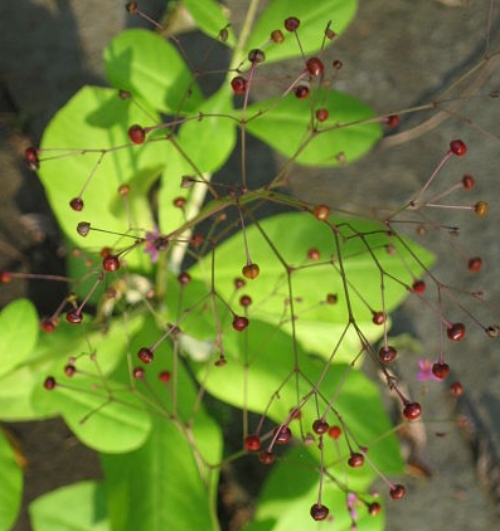Finding jewels
/Jewels of Opar with its tiny bead-like seed pods. vjs
I admit it – I’ve quite a bit less gung-ho in the garden this season. As sometimes happens even with your fondest enterprises, life gets in the way. And the heat this season has had me hiding inside.
I didn’t do a lot of the things I usually do as a matter of course. I never got tomatoes in. I never potted up herbs for my doorstep. And I never filled my 101 pots with annuals, tropicals, palm trees and horticultural curiosities. (Okay, it’s only 66 pottery containers and assorted hanging baskets, but still…)
So, I was thrilled to discover that I had a gaggle of little plants I absolutely love growing where I neither sowed nor toiled nor watered nor pruned. At one corner of the patio, some half-familiar chartreuse leaves emerged this June. They were interesting enough as young sprouts that I didn’t pluck them right out but rather invoked the gardener’s ever-hopeful mantra “Let’s see what happens!” In due course it became clear what I had: Jewels of Opar!
How can you resist a plant whose name evokes a mythic city of gold and riches? The name rolls off the tongue redolent with exotic allure, strange customs and stranger tales of derring-do. Edgar Rice Burroughs put the place on the map with “Tarzan and the Jewels of Opar,” published in 1918 as the fifth book in his adventure series.
Long story short: Tarzan goes off to find the mysterious city, home to a lost colony of Atlantis, seeking its legendary treasure trove of gold, jewels and precious spices. He becomes entangled with a high priestess named La, wrestles lions to the death, survives an earthquake and lives to play another day in Episode Six – exactly what you would expect from an early 20th century action hero.
Opar is clearly just a slight corruption of Ophir, a fabled city of unimaginable wealth referenced in Biblical, Arabic and Ethiopian sources. Trouble is, none of these sources agree where exactly in Africa this fabled city was located. Poets, theologians and spinners-of-tales to follow thought Ophir might actually be Peru or Asia, “in front of China towards the sea.”
But I digress.
The flower and emerging seed case. Mauricio Mercadante/Flickr
Jewels of Opar, otherwise known as Talinum paniculatum, is a charming little plant that I have wanted to grow since I stumbled across it in the pages of some obscure book or catalog many years ago. Last summer, lo and behold, I found one – not on some distant, steamy continent but at a garden center in Holmdel. My find was one of the varieties with chartreuse leaves, probably ‘Kingwood’ or ‘Limon.’ Score!
This isn’t a plant that makes a splash from a distance. No, this little gem is best enjoyed up close. From a base of fleshy leaves come thin, flexible stems studded with minute pink flowers. When these fade, they are succeeded by tiny little beads (actually seed cases) of orange, scarlet, burgundy and gold – little jewels that persist well into late October, when hard frost will kill the top growth.
It’s a delightful thing with the delicacy of baby’s breath, ideal for a container, and I originally had it growing with the vivid coleus ‘Sedona’ in sunset colors of orange and purple and some dark, purplish-blue angelonia. Very nice!
This is ordinarily a plant of subtropical climes, Hardiness Zones 9 – 11. It’s a New World plant, hailing from points south and west of Mississippi straight down through Central America to northern regions of South America. (Maybe Ophir, Peru isn’t so implausible?)
It can be grown as an annual farther north, but generally doesn’t survive cold winters. I can probably thank the heat trap of a sheltered bluestone patio for the successful germination of my two dozen or so self-sown seeds. I’ve read that the rootstock forms a carrot-like tuber that can survive adverse conditions (although probably not prolonged deep freezes). It’s a fluke mine survived but meanwhile, I’m charmed. And they did it all by themselves!
I know that next thing someone will ask is “Where can I get one?” Short of a lucky find at a local garden shop, you’d probably be looking for seeds. Even these aren’t easy to come by. You can find some seed sources online: Plant World Seeds and World of Succulents are two.
I understand that these plants produce seeds quite prolifically, so it is very possible I can save some to have a future supply. It’s also very possible I’d actually have to do some work here, harvesting, storing and sowing, rather than letting Nature take its course. Frankly, my dears, I like even better the notion that something can come from doing nothing at all.


